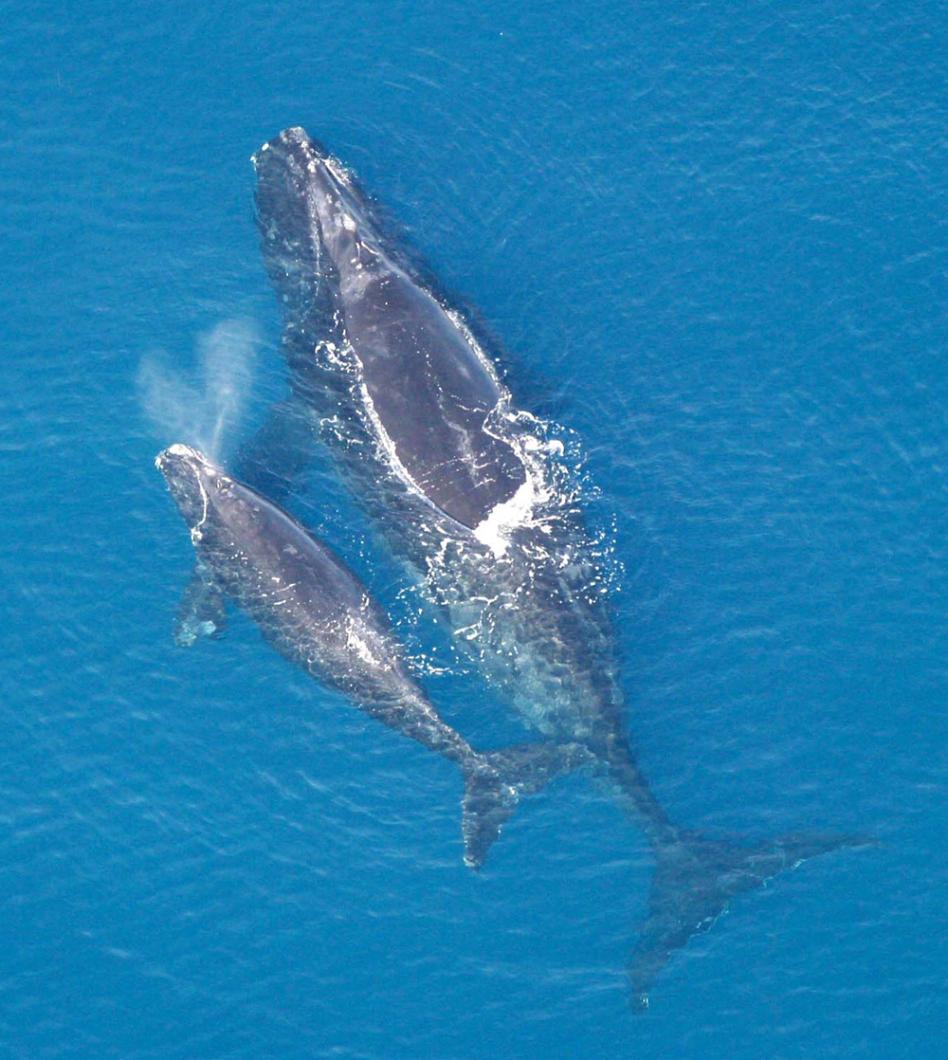The rare right whales sighted last month off Block Island and off Martha’s Vineyard and Nantucket have left — but their presence has brought about a shift in thinking in the scientific community.
Last weekend, only one right whale was spotted off the Rhode Island shoreline by the Coast Guard. It is believed the animals have moved to the waters off Chatham or Provincetown and into Cape Cod Bay.
But last month, federal scientists counted 98 right whales in close proximity near Block Island, and they documented a number of whales closer to the Vineyard, too.
The aggregation is the largest in the history of protecting the whale in New England, since the federal and state governments began monitoring the animal as endangered decades ago.
It was an unusual event in an unusual place. Most right whales move up the Atlantic seaboard and don’t visit these waters, except on the rarest of occasions. Most sightings are in Cape Cod Bay where the animals are known to spend the late spring in large numbers. Work has been done by the National Marine Fisheries Service, and aerial flights have been conducted by the Provincetown Center for Coastal Studies.
“With a record sighting of 98 right whales April 20 in Rhode Island Sound by our aerial team as part of their routine regional survey work, there has been interest in checking back to see if right whales are still there or if they have moved to the northeast as expected,” said Shelley Dawicki, of the National Marine Fisheries Service, in Woods Hole.
Flights last Saturday by scientists with the Provincetown Center for Coastal Studies over those waters came up empty. “We did receive a report from the Coast Guard at Point Judith of one right whale, so they apparently haven’t all left that area, but it appears many have,” Ms. Dawicki said.
Charles (Stormy) Mayo, senior scientist with the coastal center who has studied right whales since 1975, said the size of the aggregation was huge. “It may be the largest aggregation anywhere in the entire Atlantic. We’ve seen 71 and we consider that high,” Mr. Mayo said.
“I think this is exciting. It is really quite extraordinary,” Mr. Mayo said. “Whales, right whales in particular, are in constant search for food. They can be likened to grazers.” The news doesn’t just say something positive about whales; it also says a lot about the local waters’ value as a resource for food, whale food and fish food.
For Erin Burke, protected species biologist at the state Division of Marine Fisheries, the appearance of these right whales goes beyond being rare, it could be an indication of growth, and the animals returning to their historic grounds. It may be a big positive sign for the 450 known right whales in the Atlantic.
“It is known that the population is growing by one per cent a year. They could be spreading,” she said.
The Great South Channel off Chatham is a familiar spot to see right whales as they migrate up the coast in the spring. “Martha’s Vineyard isn’t that far away,” she said.
Ms. Burke said she wonders how the whole aggregation got word that their favorite food was off Rhode Island. “Maybe somebody [one of the whales] found it and communicated it to the others,” she said. And now that the animals know there was a good meal off Rhode Island, will they have a collective memory and come back again next spring?
Tim Cole is a fisheries biologist for the National Marine Fisheries Science Center. He routinely flies over the waters off New England doing aerial surveys of whales. In spring the whales are in New England waters. In summer they are in the Canadian Maritimes.
Mr. Cole said there were several sightings around Nantucket and Martha’s Vineyard leading up to the Rhode Island discovery.
Mr. Cole said next spring he and others will step up their interest in surveying these waters again, earlier, to get ahead of a possible reappearance.
To stop the decline of right whales in the Atlantic, the federal and state agencies have stepped up protective measures through new fisheries and boat traffic regulations.
In January 2007, all lobstermen, conch fishermen and pot fishermen in Massachusetts were required to use sinking line when connecting buoys to their fishing pots. The action was taken in response to the concern that floating line was causing whale entanglements. It was an expensive change, and fishermen protested vigorously. Ms. Burke said the idea of taking steps to protect marine mammals in Vineyard and Nantucket waters is further justified by this spring’s whale sightings.
There are federal restrictions on boat speed when whales are known to be near. Wayne Lamson, general manager of the Steamship Authority, said captains pay attention to the notices issued about whale sightings.
He said several times during the year his captains have learned of reports of sightings of whales south of Nantucket and the Vineyard.
Though the operating routes of the ferryboats are on the north side of the Islands, Mr. Lamson said the restrictions for mariners, which extend well out from the area of sighting, create challenges for captains even when whales are far away.
“The National Marine Fisheries Service issues an alert that can take effect for 30 days at a time,” he said.
When there is an alert, to prevent whale strikes, Mr. Lamson said captains will often post an extra lookout on the bridge: “To make sure that if we do see anything, we can try and steer away.”







Comments
Comment policy »